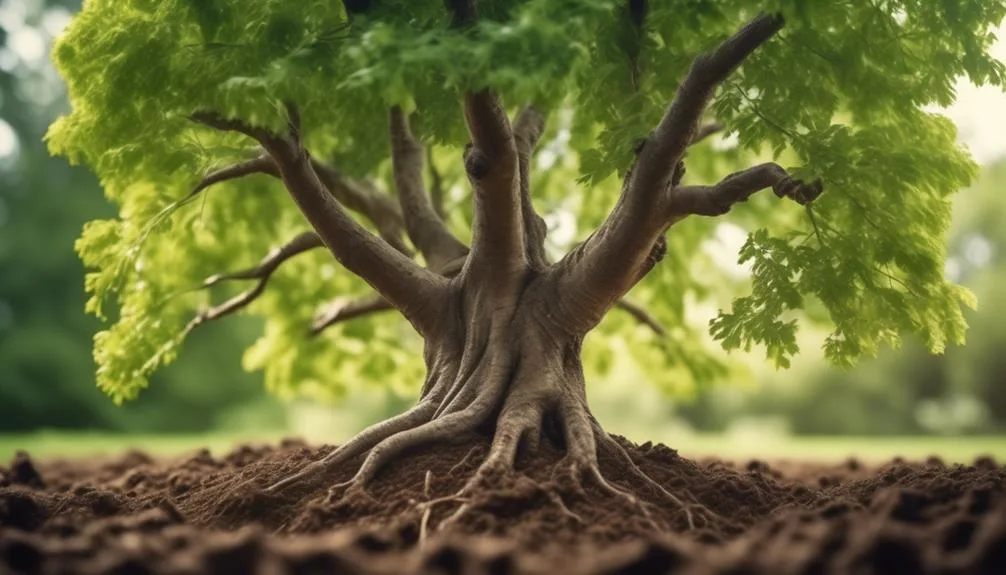Curious about whether elm trees can thrive in acidic soils?
Imagine a homeowner wanting to plant an elm tree in acidic soil but unsure if it's suitable.
Let's explore the adaptability of elm trees to different soil pH levels and how acidic soils can impact their growth.
Can elm trees truly thrive in acidic soils, or will they struggle to survive?
Stay tuned to uncover the fascinating relationship between elm trees and acidic soils.
Elm Trees and Soil Ph
When growing elm trees in acidic soils, it's important to understand how soil pH directly impacts their health and growth. Soil amendments play a crucial role in ensuring that the soil pH is within the optimal range for elm trees.
Adding lime to acidic soils can help raise the pH, creating a more suitable environment for elm trees to thrive. In comparison to other tree species, elm trees generally prefer a slightly acidic to neutral pH range of 6.0 to 7.5.
It's essential to monitor the soil pH regularly and make adjustments as needed to provide the best growing conditions for elm trees. By understanding the impact of soil pH and utilizing appropriate soil amendments, you can promote the health and vitality of elm trees in acidic soils.
Ideal Ph Range for Elm Trees
Understanding the ideal pH range for elm trees is essential for ensuring their health and growth, especially when growing them in acidic soils. Elm trees thrive in slightly acidic to neutral soils with a pH range between 6.5 and 7.5. This range provides an optimal environment for nutrient availability and uptake, supporting the tree's overall health and development. When preparing the soil for elm tree planting, it's crucial to test the pH levels and make necessary adjustments to ensure it falls within this ideal range. By maintaining the proper pH, you can enhance the soil's ability to retain essential nutrients, promoting robust growth and resilience in elm trees. Here's a table summarizing the ideal pH range for elm trees:
| pH Level | Soil Acidity |
|---|---|
| 6.5-7.5 | Slightly acidic to neutral |
Adaptability of Elm Trees to Acidity
To thrive in acidic soils, elm trees demonstrate remarkable adaptability, effectively maintaining their health and growth within a slightly acidic to neutral pH range of 6.5 to 7.5.
Elm trees are a tree species adaptable to a variety of soil conditions, including moderately acidic soils. Their soil acidity tolerance allows them to flourish in environments where other tree species may struggle.
Elm trees possess a unique ability to adjust their nutrient uptake in response to the acidity levels in the soil, ensuring their survival and growth. Their adaptability to acidity is further enhanced by their efficient root system, which aids in the extraction of essential nutrients even in acidic soils.
This adaptability makes elm trees a favorable choice for landscaping in areas with varying soil pH levels.
Effects of Acidic Soil on Elm Trees
In acidic soils, elm trees may experience reduced nutrient availability, affecting their overall growth and vitality. The challenges of acidic soil can significantly impact the health of elm trees, leading to stunted growth, yellowing leaves, and increased susceptibility to diseases and pests. Below is a table summarizing the effects of acidic soil on elm trees:
| Effects of Acidic Soil on Elm Trees |
|---|
| Reduced Nutrient Uptake |
| Stunted Growth |
| Yellowing Leaves |
| Increased Susceptibility to Diseases |
| Vulnerability to Pests |
It's important to address acidic soil challenges to maintain tree health in acidity. Implementing proper soil amendments and pH-balancing techniques can help mitigate these effects, promoting the well-being and resilience of elm trees in acidic environments.
Tips for Growing Elm Trees in Acidic Soils
When facing the challenge of growing elm trees in acidic soils, you can enhance their resilience and vitality by implementing specific cultivation practices. Consider these tips for successfully growing elm trees in acidic soils:
- Soil Amendment: Prior to planting, amend the acidic soil with organic matter such as compost, well-rotted manure, or peat moss to improve its structure and fertility. This helps to raise the pH level and create a more hospitable environment for elm trees.
- Tree Selection: Opt for elm tree varieties that are more tolerant of acidic soils. Some elm species have natural resistance to acidic conditions, making them better suited for growth in such environments.
- Monitoring and Maintenance: Regularly monitor the soil pH levels and provide ongoing care to ensure that the elm trees receive the necessary nutrients and conditions to thrive in acidic soils.
Conclusion
Incorporating the right care and attention, elm trees can thrive in acidic soils, despite their preference for slightly alkaline conditions.
Monitoring soil pH, providing adequate nutrients, and considering soil amendments are key to creating a favorable environment for successful growth.
With these considerations, cultivating elm trees in acidic soils is achievable.
Happy planting!

My interest in trees started when I first saw the giant sequoias in Yosemite.
I was a teenager then, and I remember thinking, “I need to learn more about this.”
That moment stuck with me.
A few years later, I went on to study forestry at Michigan Tech.
Since graduating, I’ve worked in a mix of hands-on tree care and community education.
I’ve spent over ten years helping people understand how to plant, maintain, and protect the trees in their neighborhoods.
I don’t see trees as just part of the landscape.
They are living things that make a real difference in our daily lives.
